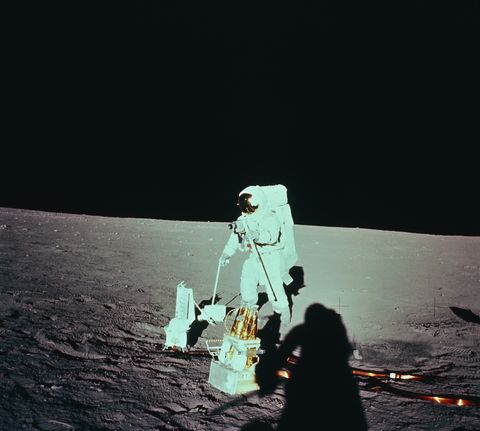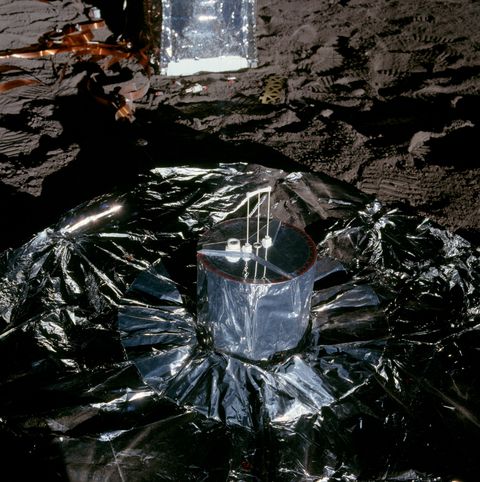The Strange Origin of the Hollow Moon Conspiracy Theory
- The hollow moon conspiracy theory came about during the Apollo missions in 1969.
- Conspiracy theorists misinterpreted the results of the astronauts’ seismic experiments, leading them to believe the moon was hollow.
- Scientists said the moon rings “like a bell.” That’s because the vibrations from the moon’s seismic events, known as moonquakes, last much longer than those on Earth.
Conspiracy theorists once believed that the moon was hollow. Though that’s more likely than the moon being made out of cheese, it still seems pretty ridiculous by today’s standards. So where did that hollow moon theory—or rather, conspiracy—come from?
Surprisingly, it isn’t based in folklore, and the tale isn’t very old, either. The hollow moon theory first came about in 1969 during the Apollo 12 moon-landing mission.
NASA researchers sought to learn more about the composition of the moon. During the Apollo 12 mission, astronauts Pete Conrad and Alan Bean set up a Passive Seismic Experiment (PSE) at the landing site as part of larger set of moon experiments known as the Apollo Lunar Surface Experiment Package (ALSEP).
More From Popular Mechanics

Once the Apollo 12 astronauts were safely back in the command module, they crashed the lunar module into the moon’s surface. The impact was the equivalent of detonating one ton of TNT and triggered what’s known as a “moonquake”—the first human-made moonquake to take place. The PSE seismometers recorded the resulting vibrations, which were much bigger and lasted much longer than the scientists had anticipated. They were far different from the earthquake vibrations we’re familiar with.
NASA continued its moonquake experiments during the Apollo 13, 14, 15, and 16 missions, with similar results.
At the time, the findings were surprising because they pointed to the moon being much less dense than Earth, and it is: the moon is only 60 percent as dense. That doesn’t mean the moon is hollow, but as with many things—like the moon landing itself—conspiracy theorists perpetuated that misinformation.
What Are Moonquakes?
The Passive Seismic Experiment seismometers placed during the Apollo 12 mission remained active until 1977, recording both natural and human-made moonquakes alike. In fact, moonquakes happen fairly regularly, as space debris like asteroids hit the moon more frequently than Earth, because the moon’s atmosphere is much less dense.
Scientists have pinpointed four types of moonquakes: deep sub-700-kilometer quakes, meteorite-caused quakes, thermal quakes, and shallow quakes occurring only 20 kilometers to 30 kilometers deep. Shallow moonquakes, like those triggered by NASA, last the longest and have the most devastating effects—some even measured up to 5.5 on the Richter scale. Shallow moonquakes do occur naturally on the moon, too, though scientists haven’t pinpointed what causes them yet.
Why Does the Moon “Ring” Like a Bell?
Here’s where things got lost in translation. “The moon was ringing like a bell,” Clive R. Neal, professor of civil engineering and geological sciences at the University of Notre Dame, says of the experiment results in a NASA writeup. And that’s true from a scientific standpoint. Similarly, the writeup also compares moonquake vibrations to those of a tuning fork, which is a kind of acoustic resonator. “It just keeps going and going,” Neal says.
However, the moon does not literally sound like a bell ringing, nor is it hollow like one. But conspiracy theorists interpreted it in that manner.
On Earth, vibrations from earthquakes typically last only 30 seconds or so and no more than two minutes. That’s largely due to the amount of water present on the planet. As Neal explains, “Water weakens stone, expanding the structure of different minerals. When energy propagates across such a compressible structure, it acts like a foam sponge—it deadens the vibrations.”
Meanwhile, the NASA-induced moonquakes all lasted over ten minutes. The Apollo 12 moonquake’s shockwave took close to eight minutes to peak after impact and around an hour to fully cease. But we now know there’s a very good, scientific explanation for it. There isn’t much water on the moon that we know of—it’s mostly in the form of ice; and the moon is drier and a lot more rigid than Earth. So, the moon’s composition allows vibrations to “ring” and continue on for a much longer period of time.
The results were surprising at the time of the Apollo missions, but we now know more about the moon’s composition. Though we’ve ruled out the moon being hollow, we have a lot to learn still.
Terry Hurford, a NASA geophysicist, is working on the new Subsurface Lunar Investigation and Monitoring Experiment (SUBLIME), which would “map the moon’s core” and gather even more data on moonquakes for the Artemis program, for instance. “Our understanding of the moon’s interior remains rudimentary and is limited,” he says in a NASA article.
When she’s not out riding her mountain bike, Jessica is an editor for Popular Mechanics. She was previously an editor for Bicycling magazine.
This article has been archived for your research. The original version from Popular Mechanics can be found here.



